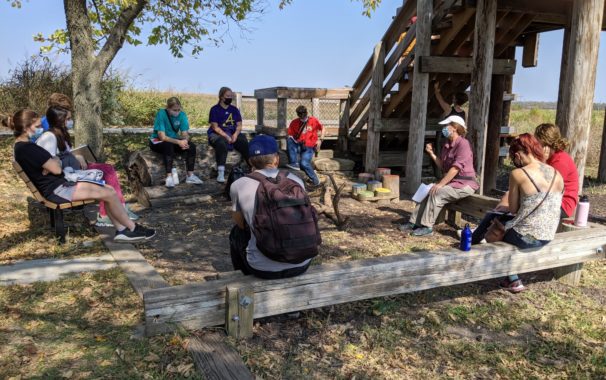What do you get when you mix Ecology and Literature? The beginning of a fruitful relationship. School of Natural and Applied Science Professor Karin Gastreich, Ph.D. and Associate Professor of English Amy Milakovic, Ph.D. teamed up to teach the Interdisciplinary Studies (IS) course Ecology Through the Writer’s Lens (ETWL).
“Karin has expertise in Ecology, and I have the same in literature. She thought of the initial idea, approached me about teaching it with her, and we built the course together,” said Milakovic.
“IS courses are designed to illustrate why certain challenges warrant interdisciplinary examination and how each discipline contributes to the process of understanding and resolution. Our university has a decades-long history of IS courses, with the basic model persisting through multiple revisions of the core curriculum. This provided an excellent context within which to implement ETWL” (Gastreich & Milakovic, 2022).
They were recently published in the Journal of Effective Teaching in Higher Education (JETHE) for their work. JETHE is an open-access electronic peer-reviewed journal that advances the scholarship of teaching and learning (SoTL) in institutions of higher education. The journal encourages critical conversations about SoTL from faculty members with interdisciplinary perspectives.
“In a time of global challenges such as climate change, large-scale habitat destruction, and emerging infectious diseases, we face a critical need to expand the understanding of science while strengthening connections to nature” (Gastreich & Milakovic, 2022).
“ETWL allows students to explore an ecosystem of critical importance, the tallgrass prairie, through an interdisciplinary field experience. ETWL allowed students from diverse backgrounds to collaborate in a focused, interdisciplinary exploration of the natural world. This model helped students develop an appreciation for the scientific process, creative literature, and wild spaces” (Gastreich & Milakovic, 2022).
ETWL is a field study course, allowing students to study nature and apply their findings to several types of writing. “For most years of the course, we have visited Konza Prairie Biological Station. The station is located outside of Manhattan, Kansas, and is maintained by Kansas State University,” said Gastreich.
“The Flint Hills is a beautiful region of the Midwest. They are flat-topped hills with deep valleys. Most of the region has prairie and grazed grassland. Because of the type of grazing done over the last century or so, this area has some of the most important and well-preserved remnants of the tallgrass prairie in existence today. We go in autumn, usually before the first cold snap. So there is still quite a bit of activity, even though the grasses have turned golden-brown, and autumn colors drape the landscape. Students have the opportunity to see quite a bit of wildlife, including wild turkey, deer, several bird and insect species, and bison. We have heard coyotes at night but haven’t spotted them on the course. The group stays in two small cabins, and we cook all our food together. In addition to other field activities, we receive a guided tour from one of the research scientists at the station.”
There are odes, haikus, and reflective journaling. Students were immersed in field trails, lowland galley forests, limestone ledges, farmsteads, and upland tallgrass prairie. They were required to sit, observe, and write for 20 minutes each time. “This requirement helped ensure that they fully inhabited the time and space and thus captured impressions lost without a slower, contemplative pace” (Gastreich & Milakovic, 2022). Students wrote from each of their finely tuned senses and “from a God’s-eye view: colors, vegetation, animal presence, sounds, sensations of sun and wind, and the like.”
Students were required to create a final literary piece of their choosing to document and reflect upon their experience. They composed everything from screenplays to illustrated books for first graders.
The following observations were taken from the journal article and represent excerpts from different integrative assignments and course evaluations from students following the immersive field experience.
“When I observed the prairie, I did not see just land; I saw a community of all types of life that had a common goal of surviving. . .”
“. . . the writing allowed me to see and feel the connections that my classmates made to the prairie. I could see how their views had changed as they read their pieces. Even if I was not there when they had their experience, I could feel what they went through.”
“We became more of a community who now cared and learned about something bigger than us. . .”
“Science can use literary work to tell the truths about the world . . . using creative means to get people interested in nature can help make a domino effect of people wanting change in the world.”
In recent years, during the height of the Covid pandemic, the class took advantage of some local restoration sites, including Jerry Smith Park in Kansas City and Baker Wetlands in Lawrence, KS.
Avila IS courses are and will continue to be an opportunity for students to study a subject from experts in two different disciplines. Avila currently offers 35 IS courses ranging from Psychology of Film to Global Bioethics. Gastreich also teaches “Women and Science,” and Milakovic has taught “The ‘Art’ of War.”



